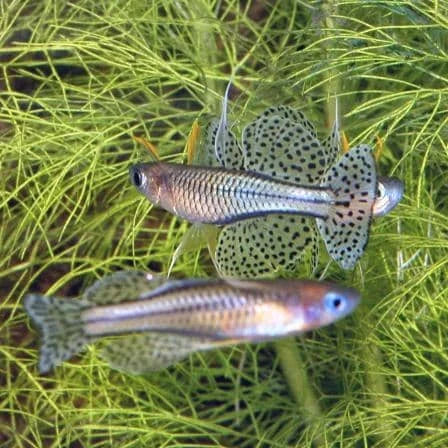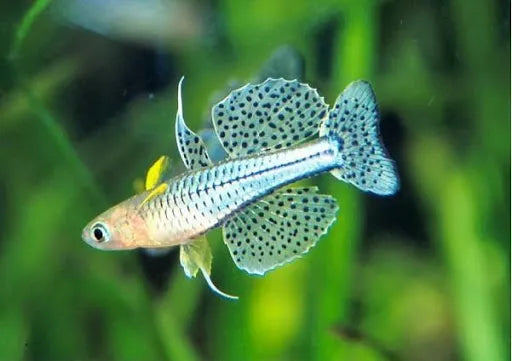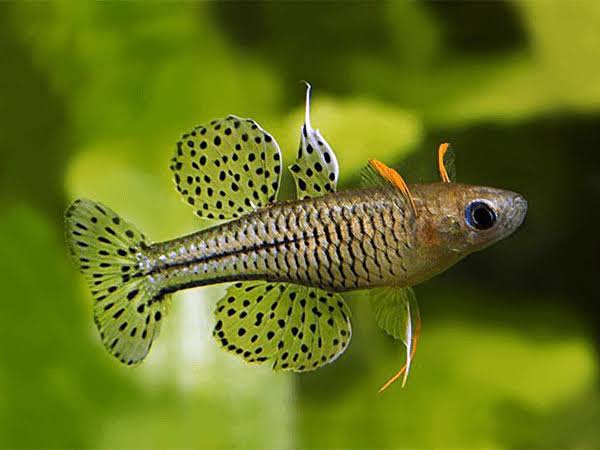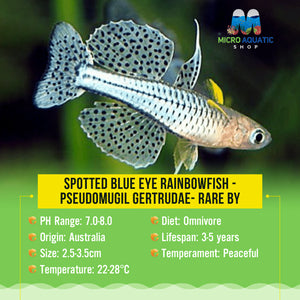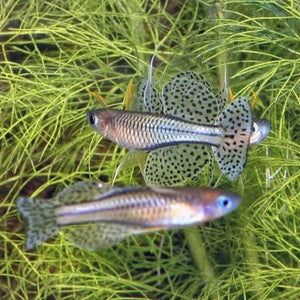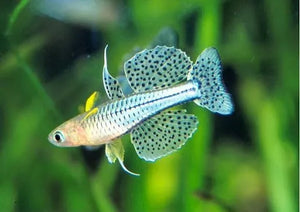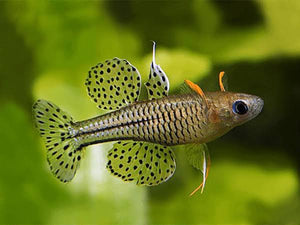Spotted Blue Eye - Pseudomugil Gertrudae- Rare 2cm
Guarantee Safe Checkout
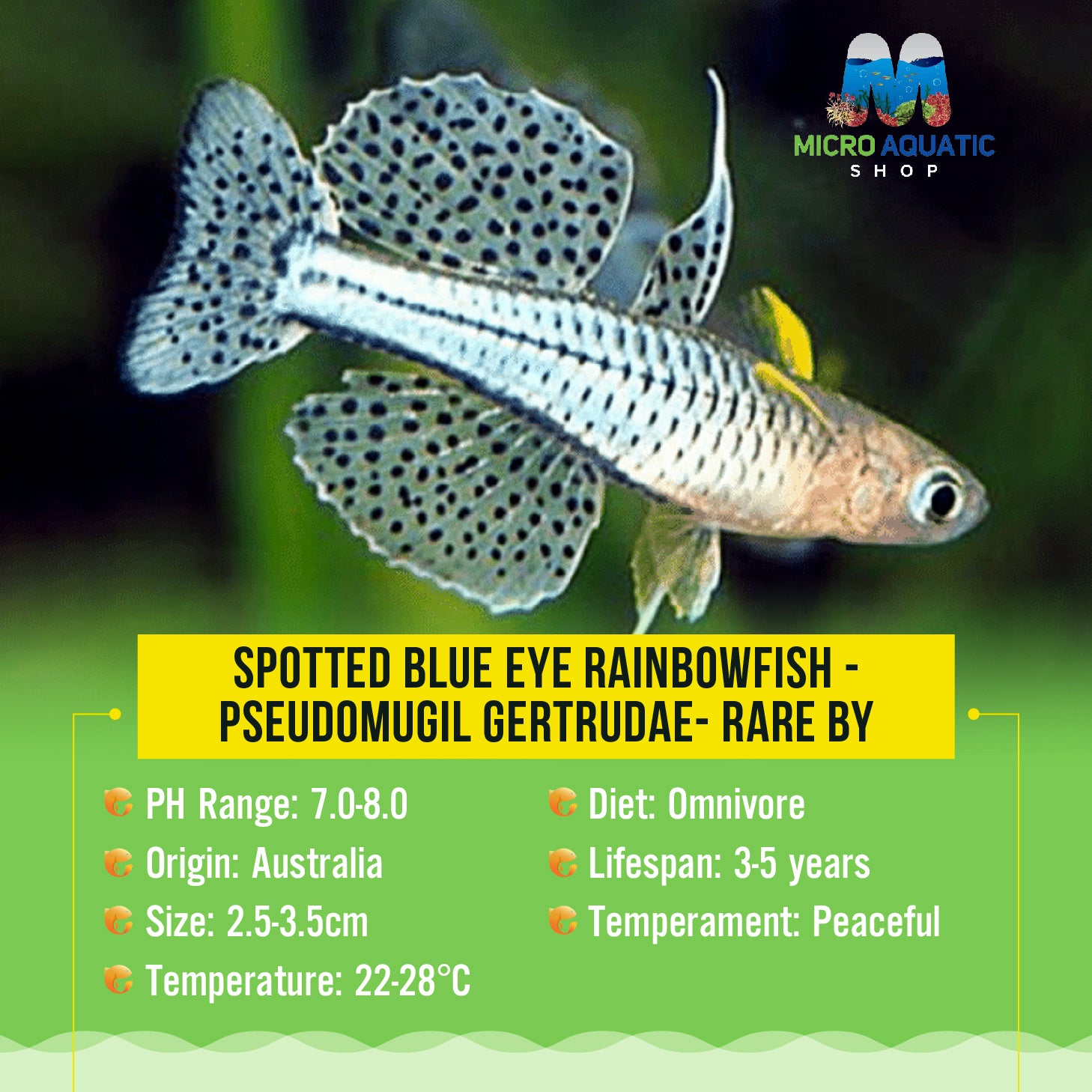
Spotted Blue Eye - Pseudomugil Gertrudae- Rare 2cm
Spotted Blue Eye (Pseudomugil Gertrudae) - Stunning Rainbowfish
The Spotted Blue Eye, or Pseudomugil Gertrudae, is a standout in Australia's freshwater world. It's a member of the rainbowfish family, loved by many aquarium fans. Its beauty is undeniable.  This fish comes from Australia's north. It loves the calm waters of our forests and coastal areas. Its colours and actions make it a joy to watch and care for at home.
This fish comes from Australia's north. It loves the calm waters of our forests and coastal areas. Its colours and actions make it a joy to watch and care for at home.
Key Takeaways
- The Spotted Blue Eye is a stunning native Australian rainbowfish species
- It is known for its vibrant colouration and captivating behaviour
- This fish is a popular choice among aquarium enthusiasts for its beauty and suitability for home aquariums
- Exploring the Spotted Blue Eye's natural habitat, physical characteristics, and care requirements will help you create the perfect environment for this enchanting fish
- Careful consideration of the Spotted Blue Eye's dietary needs, breeding habits, and health management is essential for successful long-term care
Introducing the Pseudomugil Gertrudae, Spotted Blue Eye
The Pseudomugil Gertrudae, or Spotted Blue Eye, is a stunning fish from the Melanotaeniidae family. This family is known for their vibrant colours and unique traits. The Spotted Blue Eye is a small, captivating fish from the Pseudomugil genus that has won the hearts of many aquarium lovers.
Natural Habitat and Distribution
The Spotted Blue Eye is mainly found in eastern Australia's coastal areas. It thrives in the freshwater streams, creeks, and swamps of Queensland and New South Wales. These Australian native species are well-suited to their diverse aquatic homes, living alongside many other Melanotaeniidae family members.
Physical Characteristics
The Spotted Blue Eye is a small, delicate fish, reaching up to 4 centimetres in length. It has a slender body and a bright blue eye, which gives it its name. Its fins are also special, often showing a beautiful iridescent sheen.
Behavioural Traits
These blue eye species are known for being peaceful and social. They often form small, cohesive schools that move gracefully through the water. The Spotted Blue Eye is also known for its curious and interactive nature, making it a joy to have in a well-maintained aquarium.
Setting Up the Perfect Aquarium Environment
Keeping aquarium fish like the Spotted Blue Eye is a joy. These freshwater fish need a special setup to thrive. Let's look at what makes a great home for these colorful rainbowfish.
Tank Size and Water Parameters
Spotted Blue Eyes prefer a big tank, at least 20 gallons. Keep the water between 22-28°C (72-82°F) and pH 6.5-7.5. Regular water changes and a good filter are key for clean water.
Aquarium Decor and Planting
- Use lots of live plants like Java Fern, Anubias, and Vallisneria to mimic their natural home.
- Add driftwood, rocks, and caves for hiding spots, making your fish feel safe.
- Choose a soft, sandy substrate to match their natural environment.
Ideal Tank Mates
Spotted Blue Eyes are friendly and like to be in a community. Good tank mates include:
- Peaceful aquarium fish like Tetras, Rasboras, and Corydoras Catfish.
- Small, peaceful shrimp like Amano or Cherry Shrimp.
- Snails like Nerite or Mystery Snails.
With the right tank size, water, décor, and tank mates, your Spotted Blue Eye rainbowfish will thrive.
Dietary Requirements and Feeding Habits
Caring for our beloved rainbowfish, the Pseudomugil gertrudae or Spotted Blue Eye, means knowing their diet and feeding schedule. These vibrant aquarium fish need specific nutrients to stay healthy and colourful.
Live Food Options
In the wild, Spotted Blue Eyes eat small live prey like:
- Brine shrimp
- Daphnia
- Micro worms
- Infusoria
Adding these live foods to their diet is best. It gives them essential nutrients and makes their aquarium more interesting.
Commercial Feed Alternatives
But live foods can be hard to keep up with. High-quality commercial flakes, granules, or pellets are good alternatives. These are made to give rainbowfish the vitamins and proteins they need.
Feeding Schedule
It's important to feed our Spotted Blue Eyes regularly. Small, frequent meals are better than big ones less often. This helps them eat like they do in the wild and keeps them healthy.
| Feeding Type | Quantity | Frequency |
| Live Food | A pinch or small amount | 2-3 times per day |
| Commercial Feed | A small sprinkle or a few flakes/granules | 1-2 times per day |
By sticking to these feeding tips, our Spotted Blue Eye rainbowfish will do well. They'll show off their beautiful colours and natural behaviour for everyone to see.
Breeding and Reproduction Guide
For Pseudomugil genus fans, breeding the blue eye species is a fun challenge. The Spotted Blue Eye is a unique freshwater fish to breed in our tanks.  To get them to spawn, we need to set up the breeding tank right. We should add lots of plants and fine leaves. This makes the blue eye species feel safe and ready to spawn. Keeping the water clean and the light soft also helps.
To get them to spawn, we need to set up the breeding tank right. We should add lots of plants and fine leaves. This makes the blue eye species feel safe and ready to spawn. Keeping the water clean and the light soft also helps.
- Watch for signs like chasing and bright colours to know when they're ready to spawn.
- Collect and keep the eggs safe until they hatch.
- Feed the baby fish lots of tiny food and protein to help them grow fast.
With careful watching and detail, we can raise these beautiful freshwater fish. We can then share the Spotted Blue Eye with others who love aquariums.
Health Management and Common Issues
We love our Spotted Blue Eyes and want them to stay healthy. In this section, we'll talk about common health problems they might face. We'll also share tips on preventing diseases, keeping water quality right, and treating any issues.
Disease Prevention
Preventing diseases is key to keeping our Spotted Blue Eyes happy. Here are some steps to stay ahead:
- Use a strict quarantine for new fish to avoid spreading diseases.
- Check water parameters like pH, temperature, and hardness often.
- Change some water regularly to keep it clean and healthy.
- Feed them a balanced diet to keep them strong and healthy.
Water Quality Parameters
Good water quality is vital for our fish. For Spotted Blue Eyes, aim for these water quality ranges:
| Parameter | Optimal Range |
| pH | 6.5 - 7.5 |
| Temperature | 72°F - 82°F (22°C - 28°C) |
| Hardness | 5 - 15 dGH |
Treatment Options
If our Spotted Blue Eyes get sick, we need a plan. Here are some common problems and how to treat them:
- Ich (Ichthyophthirius multifiliis): Use a commercial ich treatment or raise the water temperature to 86°F (30°C) for 10-14 days.
- Fin rot: Change the water, use an anti-bacterial treatment, and keep the tank clean.
- Swim bladder disorder: Adjust their diet, ensure good water quality, and consider a mild treatment.
By being proactive in health care, we can keep our Spotted Blue Eyes happy and healthy. This brings us joy in our aquarium adventures.
Conclusion
The Pseudomugil Gertrudae, or Spotted Blue Eye, is a stunning Australian native species. It's perfect for home aquariums. These fish have bright blue colors and spots, making them a joy to watch and care for.  To keep these Spotted Blue Eyes happy, we need the right tank setup, a good diet, and to watch their health closely. They are easy-going and don't need much care, making them great for both new and seasoned fish keepers. Looking after our Pseudomugil Gertrudae is more than just a hobby. It's also about helping protect native Australian species. By caring for these fish, we help keep Australia's unique water life safe. Let's keep loving and protecting our country's natural treasures.
To keep these Spotted Blue Eyes happy, we need the right tank setup, a good diet, and to watch their health closely. They are easy-going and don't need much care, making them great for both new and seasoned fish keepers. Looking after our Pseudomugil Gertrudae is more than just a hobby. It's also about helping protect native Australian species. By caring for these fish, we help keep Australia's unique water life safe. Let's keep loving and protecting our country's natural treasures.
FAQ
What is the Spotted Blue Eye (Pseudomugil Gertrudae)?
The Spotted Blue Eye, or Pseudomugil Gertrudae, is a stunning native Australian rainbowfish. It's a favourite among freshwater aquarium fans. These fish are known for their bright blue colour and delicate spots.
Where can the Spotted Blue Eye be found in the wild?
The Spotted Blue Eye is found in Australia. It lives in coastal areas from southeastern Queensland to eastern Victoria. They love slow-moving streams, wetlands, and shallow lakes.
What are the physical characteristics of the Spotted Blue Eye?
Pseudomugil Gertrudae is a small fish, growing up to 4-5 centimetres long. They have a slender shape and a 'blue eye' look. Males have more vibrant colours than females.
How do Spotted Blue Eyes behave in an aquarium setting?
Spotted Blue Eyes are peaceful and like to be in groups. They swim actively and prefer the middle to upper parts of the tank. They're great tank mates for other community fish.
What are the essential requirements for setting up a Spotted Blue Eye aquarium?
For a great Spotted Blue Eye tank, use a 60-litre tank. Add lots of plants and hiding spots. The water should be slightly acidic, with a pH of 6.0 to 7.5 and a temperature of 22-26°C. Regular water changes and gentle flow are key for good water quality.
What do Spotted Blue Eyes eat, and how should they be fed?
In the wild, they eat small crustaceans, insects, and algae. In tanks, feed them live foods like brine shrimp and daphnia. Also, give them high-quality flakes or granular food. Feed them often but in small amounts for a balanced diet.
How can Spotted Blue Eyes be bred in an aquarium setting?
Breeding Spotted Blue Eyes is rewarding. Use a breeding tank with soft, acidic water and lots of plants. Add fresh, oxygenated water to encourage breeding. The eggs stick to plants or surfaces.
What common health issues should aquarists be aware of when keeping Spotted Blue Eyes?
Keeping the water quality right is key for Spotted Blue Eyes. Watch out for fin rot, ich, and bacterial infections. Regular water tests and quick treatment can prevent and manage these problems.
| Quantity |
1 fish unsexed, 3 fish unsexed, 6 fish unsexed |
|---|

